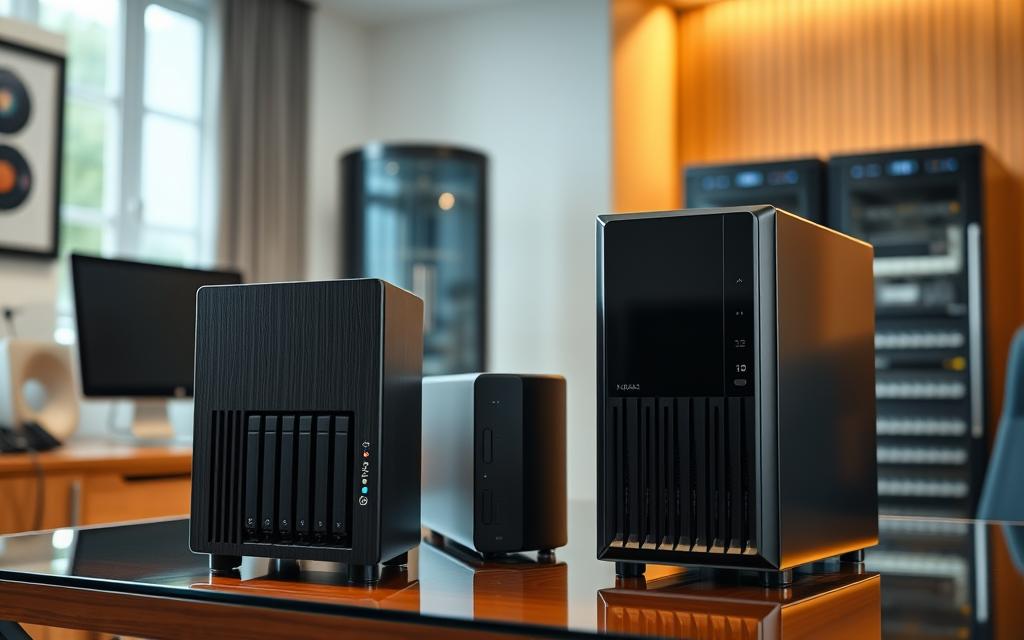In today’s digital world, managing data well is key for all businesses. Network attached storage is a smart way to keep your digital stuff in one place.
A NAS device is like a special computer on your network. It has its own address and you can access it with a web browser. It’s a system for storing files that many people can use from different devices.
People connect to it using Ethernet cables in their local network. This makes it easy to get to your files and documents anywhere in your organisation.
This tech is great for big companies and small ones too. It changes how we store and share data, making it more open and easy to use.
Learning about network attached storage helps businesses choose the right way to handle their data. This knowledge is key to setting up efficient digital work processes.
What is NAS Technology?
Network-attached storage, or NAS, is a special way to store files. It lets many users and devices get to their data over a network. This makes it easier and safer for companies to manage their data.
Core Components of a NAS System
A NAS device has key parts that work together. These parts make sure the system runs well and keeps data safe.
The heart of a NAS is its storage drives. These can be hard disk drives (HDDs) or solid-state drives (SSDs). They’re set up in a special way to hold lots of data and keep it safe.
A NAS also has a special processor. This processor handles all the file work and network talks. It runs a special operating system made just for sharing files.
Network interfaces connect the NAS to other devices. Most have Gigabit Ethernet ports. Some even have 10GbE for faster speeds.
How NAS Differs from Other Storage Solutions
Knowing the difference between SAN vs NAS helps pick the right storage. Each has its own role in business settings.
Storage Area Networks (SANs) give raw storage to servers. NAS, on the other hand, shares files directly. This changes how they work and are used.
NAS is better than Direct-Attached Storage (DAS) for sharing. DAS is for one computer, but NAS is for many. This is great for teams working together.
Media companies use NAS for big files. Teams can access high-quality images and videos easily. They don’t have to worry about making copies or keeping track of versions.
| Storage Type | Access Level | Primary Protocol | Typical Use Case |
|---|---|---|---|
| NAS | File-level | NFS/SMB | Departmental file sharing |
| SAN | Block-level | Fibre Channel | Database storage |
| DAS | Block-level | SATA/SAS | Single-server storage |
The main difference is in the protocols. NAS uses NFS and SMB for files. SAN uses Fibre Channel or iSCSI for blocks.
For teams, NAS is a big win. It’s easy to set up and manage. It’s perfect for companies that don’t have a team just for storage.
How Network-Attached Storage Works
Network-attached storage systems use special hardware and smart software. They connect to your local network. They act as central places for storing and getting data.
When you ask for a file, the NAS device works it out. It checks who can see the file and how it’s organised. Then, it sends the file back to your device.

The Role of Network Protocols in NAS
Network protocols help NAS systems talk to different devices. The TCP/IP protocol makes sure data gets sent right. This is key for reliable information sharing.
There are file-sharing protocols for different systems:
- Server Message Block (SMB): Works best with Windows
- Network File System (NFS): Great for Linux and Unix
- Apple Filing Protocol (AFP): Best for macOS
These protocols make sure NAS systems can handle file requests well. This means businesses can use one storage system for all their devices.
In big companies, NAS protocols help with things like virtual desktops and streaming. They handle lots of requests at once. They keep data safe and sound.
Companies can pick between scale-up NAS or scale-out NAS. Both use network protocols to keep performance up as they grow.
The way protocols work affects how fast you can get data. New NAS systems often have better protocols. These make things faster and more reliable.
Key Advantages of Implementing NAS
NAS systems do more than just store data. They change how businesses handle their data. This brings real benefits to how they work.
Enhanced Data Accessibility and Collaboration
Network attached storage helps teams work together, no matter where they are. With internet, anyone can access files from anywhere.
This makes teamwork easier. Many can work on the same document at the same time. There’s no worry about version conflicts.
Cloud integration adds even more benefits. Many NAS systems work with cloud services. This creates a hybrid storage solution.
Improved Data Security and Redundancy
NAS devices have built-in protection for your data. RAID setups make copies of your data on different drives.
This means your data is safe even if a drive fails. You can keep working because other drives have your data.
They also have encryption. This keeps your data safe from hackers, both when it’s stored and when it’s being moved.
Cost-Effectiveness and Scalability
NAS is cheaper than using dedicated servers. It costs less to buy and maintain.
It’s also easy to grow with your data needs. You can start small and add more storage as needed.
There are two ways to scale:
- Scale-up: Adding bigger drives to what you already have
- Scale-out: Adding more storage units
This makes NAS perfect for growing businesses. Small businesses use it for backups. Big companies use it for storing lots of data.
Types of NAS Systems for Different Needs
Choosing the right NAS device depends on your organisation’s size and data needs. There are systems for small offices and big data centres. Each type meets different needs.

Desktop NAS Devices for Small Businesses
Desktop NAS systems are great for small businesses and home offices. They are small, support 2-5 drives, and are easy to set up.
They are good for sharing files and streaming media. They have enough space for teams to work together without needing a lot of setup.
These systems are easy to use. They come with apps for remote access. This is perfect for teams working from different places.
Rackmount NAS for Enterprise Environments
Big organisations need NAS systems that can handle a lot of data. Rackmount systems are built for this. They offer the power needed for important tasks and big data jobs.
These units have features like hot-swappable drives and extra power supplies. Companies like Dell and IBM make rackmount NAS. They support clustering well.
Enterprise NAS systems can grow in two ways. Scale-up NAS adds bigger drives to existing units. Scale-out NAS adds more nodes to create a storage cluster.
Choosing between scale-up and scale-out depends on your needs. Scale-out systems get better with more nodes. They’re great for growing fast.
Rackmount solutions work with many protocols and fit well with other IT systems. They are built to keep working even when it’s busy.
Setting Up a NAS System: Key Considerations
Setting up a network-attached storage system needs careful planning. You must choose the right hardware and configure the software well. It’s important to think about technical specs, the environment, and how the system will grow.
Organisations should think about what they need now and what they might need later. This balance is key to a successful NAS setup.
Choosing the Right Hardware and Capacity
Choosing the right storage drives is the first step. Businesses often pick between hard disk drives (HDDs) for more storage or solid-state drives (SSDs) for speed. Many systems let you mix both for different needs.
The size of the system matters too. Tower units are good for small offices, while rackmount systems fit well in data centres. Make sure the system fits in the space you have and can be cooled properly.
When it comes to connecting to the network, you have options. You can use Gigabit Ethernet, 10GbE, or fibre channel. Wireless options are available but should not be the main way to connect to your NAS.
Using RAID helps protect your data from loss. You can choose from RAID 1 for mirroring, RAID 5 for a balance, RAID 6 for more protection, or RAID 10 for both mirroring and striping.
When planning your storage, think about what you need now and what you might need later. Experts say to add 20-30% extra space to grow with your needs.
Configuring Software and Network Settings
Installing the operating system is the first step in setting up your NAS. Most systems have easy-to-use web interfaces. These guides you through the setup process.
Setting up your network is next. You need to give your NAS a static IP address so it’s always accessible. Make sure your subnet masks and gateway settings match your network. Good DNS settings help find your NAS easily.
Security is very important in a NAS setup. You need to set up user authentication, access control lists, encryption, and backup routines.
- Set up user authentication
- Use access control lists (ACLs)
- Encrypt sensitive data
- Set up backups
How you access your data is also important. Most use SMB/CIFS for Windows and NFS for Unix/Linux. FTP and SFTP are good for transferring files securely.
For big setups, you might need special advice on configuring rack-mounted NAS systems. These need extra care for cooling, power, and reliability.
After setting up, you need to fine-tune your NAS. Watch how it’s doing and adjust as needed. Keeping your system up to date with firmware updates is also important.
Conclusion
Network-attached storage (NAS) is a smart way to handle file storage today. It offers centralised data management and works well in many settings. This is great for businesses of all sizes, making data access easy and safe.
NAS is getting even better with the help of hybrid cloud and AI. These new features make managing data easier. This means NAS will be key in our digital future.
Using NAS gives businesses a big edge in the data world. It helps them store files well and keeps costs down. It’s perfect for teams that need to work together on data safely and reliably.







